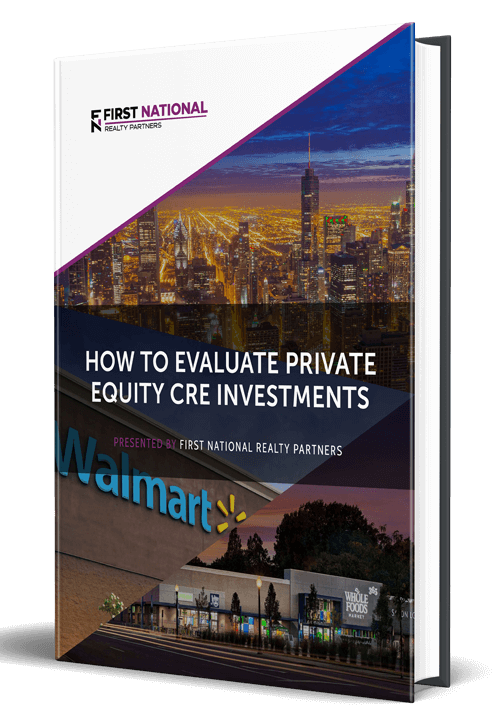Self-Directed IRA Real Estate Rules
In a typical IRA, the investment options are somewhat limited to traditional asset classes like stocks and bonds. While this may be fine for many investors, there are some individuals who prefer both the freedom to make their own investment decisions and a more diverse set of investment options – that includes commercial real estate. For these investors, opening a self-directed IRA (SD IRA) may be a more suitable option.
In this article, we are going to define what a self-directed IRA is, the risks and benefits of opening one, and how they can be used to invest in commercial real estate. By the end, readers will have all the information needed to determine if a self-directed IRA is a suitable option for their own needs and investment objectives.
First National Realty Partners is a private equity commercial real estate investment firm that specializes in the purchase and management of grocery store-anchored retail centers. If you are an accredited investor and would like to learn more about our current opportunities, click here.
What is a Self-Directed IRA?
A self-directed individual retirement account (SD IRA) is a type of IRA (Individual Retirement Account) (IRA) that can hold various alternative investments (notably, commercial real estate) that are normally excluded from a regular IRA. The account is categorized as “self-directed” because it is wholly managed by the account holder, although a custodian administers the account.
As a general rule, SD IRAs are best suited for astute investors who already understand alternative investments, like real estate, and want to diversify their portfolio within a tax-advantaged account. These IRAs can be set up as a Traditional IRA where the investor makes tax-deductible annual contributions or as a Roth IRA from which the investor takes tax-free distributions.
In order to achieve the benefits of using an SD IRA to invest in commercial real estate, investors must follow several rules that have been set forth by the Internal Revenue Service (IRS).
Rule 1: Self-Dealing
In a self-directed retirement account, the account cannot purchase a property owned by the account holder or a disqualified individual because IRS regulations stipulate that transactions cannot be “self-dealing.” Disqualified individuals include the account holder, their fiduciary, their beneficiary, and members of their family such as a spouse, ancestor, or lineal descendent.
Rule 2: The Property Must Be Uniquely Titled
The IRS stipulates that the SD IRA account holder and the IRA are two separate entities. Therefore, the investment needs to be titled in the name of the IRA and not the account holder personally. The correct title for most real estate IRAs is “Equity Trust Company Custodian FBO (Account Holder Name) IRA. FBO stands for “for benefit of” and the benefiting party is the account holder. This distinction is important because all documents related to the investment need to be titled correctly to avoid delays.
Rule 3: The Account Holder Cannot Receive “Indirect Benefits”
The SD IRA account holder cannot indirectly benefit from a property that is owned by their self-directed IRA. This rule is in place because the purpose of a Traditional IRA or Roth IRA is to provide for retirement in the future, not today. For example, the account holder is not allowed to rent any part of a property that their SD IRA holds. Other potential violations of this rule as stated in the IRS’s prohibited transaction rules list are borrowing money from the IRA or using the IRA as security for a loan.
Rule 4: Purchase the Property With a Combination of Funds
SD IRA funds can be combined with other funds to purchase real estate assets, including an undivided interest and partnerships. The key here is that the proportion invested from the IRA must be redistributed to the IRA accordingly.
Rule 5: Property Expenses Must be Paid From The IRA
Any property expenses incurred by the SD IRA must also be paid by the SD IRA, which is done by requesting funds from the IRA custodian. Examples of expenses include utilities, maintenance fees, property taxes, improvements, and condo association fees. Similarly, all rental income, sale proceeds, and other income generated by the property must be returned to the IRA custodian. If a portion of the property was financed with a non-recourse loan, then it is possible to write off the proportion of depreciation and expenses related to the property on a tax return (which can reduce the amount subject to taxation).
Rule 6: IRA Investments that Use Financing Must Pay UBIT
When a self-directed IRA invests in real estate, the percentage of profits subject to taxation is determined by the percentage of the property that is debt-financed. Therefore, if a non-recourse loan is used for a SD IRA investment, unrelated business income tax (UBIT) applies.
Rule 7: Income Generated Must Return to IRA
As discussed above, all sales proceeds, rental income, or other income generated by the purchased property must be returned to the SD IRA custodian. In addition, if the SD IRA partners to make an investment in a property, the proceeds from the investment need to be returned to the IRA account in the same proportion that the purchase was made. For example, if the Roth IRA funded 50 percent of a property purchase, then 50 percent of the sales proceeds must be distributed back to the account upon the sale of the property.
Benefits of Using a Self-Directed IRA To Invest in Commercial Real Estate
The benefits of using an SD IRA to invest in commercial real estate include:
- Protection from debt collectors
- Tax-deferred growth, which can provide significant tax advantages
- Passage of assets to heirs/family members
- Ability to invest in specialized assets, like real estate (both existing property and raw land), as a means to increase portfolio diversification
- Historical appreciation of real estate assets and a steady streams of income from rents and any income generated by the property
While these benefits are impressive, they must be weighed against the potential risks of using an IRA for commercial real estate investment.
Potential Risks of Using a Self-Directed IRA for Real Estate Investment
While SD IRAs make sense for many qualified investors, they do carry some risks that regular IRA investments may not.
To start, commercial real estate investments held within an SD IRA may be less liquid than traditional assets like stocks, mutual funds, and bonds because the acquisition and disposition of real estate can be a lengthy process, which can limit access to investment funds.
Second, there is always the risk of fraud because custodians of SD IRA funds are only responsible for administering and holding the assets. They are not liable for investigating the legitimacy of the investments in the IRAs they offer. For this reason, account holders should take all necessary steps to perform adequate due diligence before making an investment decision.
Third, there is a greater risk of violating the IRS Rules because SD IRAs are more complex than traditional IRAs. Violating an IRS rule may cause an investment or transaction to become taxable. For example, if an SD IRA is used to invest in rental properties, and the SD IRA account holder invests directly in one of those properties for even one night, the entire self-directed IRA is no longer considered an IRA as of the first day of the year in which there was a violation. This would make any gains associated with the SD IRA subject to applicable taxes and early withdrawal penalties.
To mitigate these risks, investors should have a well-developed investment strategy in place and seek investment advice from a tax expert or financial advisor before deciding if a self-directed IRA is suitable for their needs.
FAQs About Self-Directed IRA Rules
Below are some of the most commonly asked questions associated with using an SD IRA.
What is the IRS code for self-directed IRAs?
All individual retirement accounts including self-directed IRAs are covered under the Internal Revenue Code (IRC) Section 408.
How can investors use a self-directed IRA for real estate investment?
To invest in alternative assets/types of investments like real estate, collectibles, cryptocurrency, or precious metals, the IRS states that individuals must set up a self-directed IRA and invest via a passive third party. When the SD IRA has been created, investors can add funds to the self-directed IRA and instruct the custodian on which property or properties they would like to invest in.
What are the requirements to open a self-directed IRA?
To open an SD IRA, investors will need a credit card to pay the account establishment fee and a form of government-issued identification. In addition, to make a contribution to the SD IRA, the account holder (or their spouse) must have earned taxable income.
What transactions are prohibited?
According to the Internal Revenue Code (IRC) Section 408, prohibited transactions in an SD IRA include: borrowing money from it, selling property to it, using it as security for a loan, and buying property for personal use (present or future) with IRA funds. (IRS.gov)
Can I receive the rental income from the property in my IRA?
If an IRA-owned property generates rental income then all proceeds must go directly back into the IRA. The IRA owner does not physically own the property, so they can’t pocket any of the income. However, they will be entitled to the money eventually when withdrawals are made from the account at retirement.
Interested in Learning More?
First National Realty Partners is one of the country’s leading private equity commercial real estate investment firms. With an intentional focus on finding world-class, multi-tenanted assets well below intrinsic value, we seek to create superior long-term, risk-adjusted returns for our investors while creating strong economic assets for the communities we invest in.If you are an Accredited Real Estate Investor and want to learn more about our investment opportunities, contact us at (800) 605-4966 or info@fnrpusa.com for more information.






